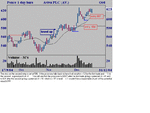barjon
Legendary member
- Messages
- 10,752
- Likes
- 1,863
afternoon all,
Last year my New Year's resolution was to try and improve my exit strategy since I felt I was leaving to much on the table and failing to get near the potential of the swing trades I had entered. My usual strategy up to then was to exit when the last swing low/high was breached. The attached chart of a trade I'm in at the moment shows the dilemma and how a trade with the proven potential of nearly +60 could finish up barely breaking even.
In pursuit of my resolution I have experimented this year with different strategies including fixed target exits; market action; trailing stops: various indicators etc but none seem to have proved wholly satisfactory.
Any thoughts?
Good trading
jon
ps: there's some commentary at the bottom of the chart in case you don't spot it first time
Last year my New Year's resolution was to try and improve my exit strategy since I felt I was leaving to much on the table and failing to get near the potential of the swing trades I had entered. My usual strategy up to then was to exit when the last swing low/high was breached. The attached chart of a trade I'm in at the moment shows the dilemma and how a trade with the proven potential of nearly +60 could finish up barely breaking even.
In pursuit of my resolution I have experimented this year with different strategies including fixed target exits; market action; trailing stops: various indicators etc but none seem to have proved wholly satisfactory.
Any thoughts?
Good trading
jon
ps: there's some commentary at the bottom of the chart in case you don't spot it first time

